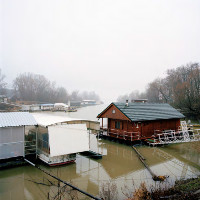|
The ‘Unseen Cities’ series explores the way in which we ‘see’ a landscape, delving into the relationship between: the physical reality of a landscape as it can be seen with the naked eye, the appearance of a landscape as it can be seen through the lens, and, ultimately, the appearance of a landscape as it can be seen after capture.
The final images presented within this series offer ‘unseen’ views of the selected landscapes as they eventually combine within a single picture different visual representations of the same physical space. Thus, they bring together various ways of ‘seeing’ a landscape, creating a picture that can be seen only on a screen or as a print.
With a 35mm-like landscape photograph as a starting point, I further exploited it by applying and making use of various effects, lens profile distortions (barrel, pincushion or mustache distortion), chromatic aberrations and transformations. I identified an array of ways in which the appearance of a landscape would change according to different lenses, focal lengths etc, and I selected the most striking cases to be included in the final images.
Therefore, the 35mm-like landscape photograph stood for the closest representation of a landscape as it could be seen with the naked eye. The changing appearance of a landscape as it was seen through different lenses was rendered by using assorted lens profile distortions and transformations. However, it was ultimately the screen (or print) that made it possible to emphasize such distortions and transformations, to ‘see’ them simultaneously and to compare them with each other and the initial 35 mm-like capture.

Project Description
Title: ‘Disclaimer’
Background: The creation of the series was inspired by the accidental finding of three amateur photographs representing a family lunch party in Communist Romania (my native country).
Series Development:
The series questions the traditional understanding of photography as a mean of representing reality and of photographer as a conveyer of truth; and further explores the space between reality and its representation, as well as the photographer’s role. Rediscovering old family photographs preserved as material objects, and creating newer, digital ones, the project investigates both the ‘material’ and ‘virtual’ potential of the images and tests out their representational force as it subjects them to similar, equalizing processes of reproduction. Therefore, the project aims to restore some meaning to the intersection between photography, reproducibility and artistic expression, suggesting a new interpretation for photography as a medium of representation.
On a first level, the projects builds up on historical, anthropological and social aspects. Therefore, it attempts to (re)create the family atmosphere, to illustrate the complex economical, social and cultural issues Romanian people were facing during Communism, and to tell their personal stories.
As the project progresses, it is suggested that Romanians’ main daily difficulties are related to food access and birth control. Thus, planning parenthood is non-existent, abortions are not allowed and women are producing themselves miscarriages using plastic tubes (hundreds of thousands of Romanian women died during Communism because of such procedures). On a more historical note, the project refers to the anti-Communist resistance grouped in the mountains and tragically crashed with traitors’ helped. The betrayals were highly rewarded with power positions and material goods. On a bitter-anecdotic note, it is mentioned that employees are stealing materials from work, that children are experiencing bullying, that in-law relationships are poorly managed, or that lovers would be taking revenge on each other by using sulphuric acid.
On a second level, the project draws on conceptual and philosophical aspects (such as philosophy of language, or legal and ethical matters). Therefore, threats on copyright infringement are brought into debate (for instance, the efficiency of fair use laws is questioned, together with the often illegal use of no-animals-were-harmed boiler plates; or various aspects related to exhibition, copying and distribution of visual imagery). Language philosophy becomes a tool in the search for proper use of terms and the quests for defining or clarifying the concepts used. In addition to this, it is also utilized to push the limits of standardized language, and suggest vicious circles that can form (“can you say ‘copyright’ with your own words?”)
However, the two levels of the project (the socioeconomic and the philosophical ones) are connected to each other, as the project raises questions related to the copyright of the images (to whom do the found photographs belong? who holds their copyright? do the artist own the full copyright for the produced imagery as this one is based on the found photographs?) or to negative checking (can the names of the ‘characters’ be confused with individuals in any real life cases?)
If the names used are common ones within the Romanian language, the featured stories are typical for the Communist Romanian society, as well. There are high chances for a nurse student to be called Nina and to have helped her sister-in-law with an illegal abortion. Or for an anti-Communist fighter to be named Tim (abbreviation for Timotei), to have spent 17 years in prison, and never to have married. A negative checking is therefore impossible. At the same time, though, all characters are ‘construed’, as I never met a certain (former) nurse student Nina, or a certain anti-Communist fighter Tim. They are all built on childhood memories, stories I was told by my grandparents or overheard when visiting, stories I have read in the post-Communist Romanian media, or stories that my mother and her friends would be sharing now with me. If, in deed, the names match the stories, that it a coincidence that I could have never avoided.
It is precisely this aspect that lies at the core of this project: If all characters are ‘construed’ (and all paper photographs are re-photographed, digitally altered and transformed into digital imagery) which is the reality that, in its traditional understanding, photography struggles to represent? Is still the artist a conveyer of truth (or a creator of ‘other’, ‘generic’ truth/reality?) Ultimately, which is now the role of the photographer?
|












